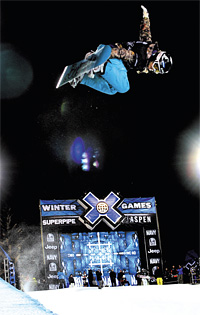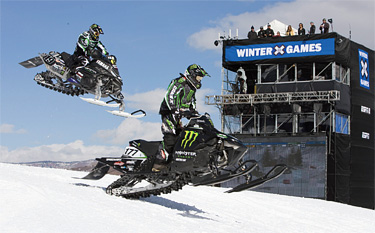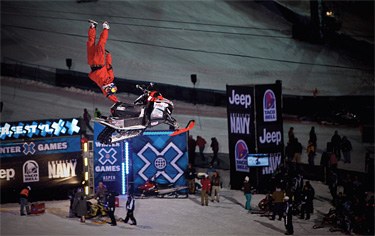Winter X Games Gets its Ollie On in 3D
ASPEN, COLO.—It was in 1997 that a handful of fearless, cutting-edge boarders and skiers hit the slopes and introduced a new generation of fans to tricks like the "Ollie" and "whiskey-flip" during the first Winter X Games in Big Bear, Calif. Fifteen years later, as the games are set to roll into Aspen for the 10th year, the Winter Games celebrate a milestone anniversary that corresponds with the first ever airing of the competition in 3D.

Hannah Teter places third for the Women's Super-Pipe during Winter X Games 14. Heather Rousseau/Shazamm/ESPN Images More than 200 athletes are expected to compete Jan. 27-30 on a series of pipes, slopes, big air jumps and tricky terrain that will air on ESPN and ESPN2 as well as on XGames.com and ESPN360.com.
But this year's biggest achievement—from a technical standpoint—will perhaps be the 18 hours of programming that ESPN will air in 3D. "With a single monoscopic camera, no matter how well we position cameras, you can't really experience the depth and height [of an event like the Winter X Games]," said Phil Orlins, coordinating producer for ESPN. "[3D] makes it immersive, as though you're actually there."
AN IDEAL VENUE FOR 3D
According to Orlins, the X Games are an ideal venue for 3D because of the manner in which events are covered: cameras are often stationed in standstill spots, with a predictable flythrough path for the athletes. "That creates layers of depth and allows you to really see the athlete jumping off the screen," he said.
That makes the Winter Games an ideal proving ground. "Most sports we cover take place in a two-dimensional playing field," he said. The X Games are played out on a constantly changing 3D surface—snow shifts under the athlete, who charges through falling show while zipping between moguls—giving depth to movements and a greater sense of speed and scope. "Unless you physically walk the course, you never get the impression of how large things really are," said Stephen Raymond, coordinating technology manager for ESPN.
The 3D experience will be spearheaded by a new camera system constructed by Pace, whose Pace Fusion 3D camera rigs will work alongside a new 3D production truck. Related 3D equipment includes technology from EVS and Sony.
"Real development has taken place in the cameras, which previously had been quite large and bulky," Raymond said. Newer models are smaller and more manageable, with lower power consumption and improvements in the control of 3D rigs, he said.

Arctic Cat Racer Jeff Tweet (177) and Yamaha's Doug Henry (19) battle it out during Adaptive snocross final at Winter X Games 14. Christian Pondella/Shazamm/ESPN Images ESPN will highlight its 3D offerings with new virtual graphics applications known as neartime visual effects. The system will employ fully integrated 3D animation with coordinated movements from a jib camera. The results are graphics that appear to blend directly into the real-time environment on screen, whether it be a sloping snow bank or virtual signage on the uppermost reaches of the ski slope, "allowing the graphics to move along with the moving image," Orlins said.
Another new technology is designed to help viewers feel as though they're speeding downhill—at a breathtaking 90 miles an hour. Using a 1,600-foot-long cable, the high-speed tracking camera known as the "Fly Cam 3D" will be positioned over the sprawling straightaway of the Snowboarder X and Skier X courses. Two other 2D Fly Cams will be in place: one positioned on the Big Air course to capture the height of the athletes as they hit their jumps, and the other on the Snowmobile venue.
The network will again use its popular Followcam technology, used to keep a close eye on skiers, boarders and snowmobilers as they make their way down the hill. This year the network will use 3D Followcams that are strapped to cameramen on skis to cover the action on the Big Air, SuperPipe and Slopestyle courses.
RETURNING TECH

Daneil Bodin competes in Snowmobile Freestyle at Winter X Games 14. Christian Pondella/Shazamm/ESPN Images Behind the scenes, ESPN has revamped some of its server infrastructure to give the production team faster access to files, said Larry Wilson, technical manager for ESPN. In additional to relying on MADI audio routing through the plant, the network will be sending discreet 5.1 audio from its production trucks in Aspen back to ESPN headquarters in Bristol, Conn.
Back again this year is the Huck Tower, a lofty 30-foot tower constructed of LED squares. As boarders and skiers take a leap off a snowy ramp, the LED tiles on the tower begin to illuminate—up, up, up—to track an athlete's progress up into the air. Athletes are outfitted with RF transmitters that send signals to receivers on the Huck Tower—the higher the athlete leaps, the higher the LED squares light up the evening sky.
To catch immense jumps, the network will also put the Strada Crane to use, a combination system that pulls a camera more than 90 feet in the air to provide sweeping views of the SuperPipe and Slopestyle courses. "It will hang out over that first vertical jump and when an athlete comes off that leap, they'll head straight up toward that camera," Orlins said.
To catch precarious shots that would be tough grab with a manned handheld unit, ESPN will use 17 robotic cameras. And to catch intricate moves on skis or snowboards, the network will turn to the I-Movix ultra slow motion device, also known as Mega Mo, which records up to 4,500 frames per second.
A total of eight production trucks will roll into Aspen, including several NEP Supershooter production trucks, including the NEP SS21, SS25 and NCP10. Equipment on scene includes a mix of 2D Sony HD cameras, Fujinon 3D lenses, Canon and Fujinon 2D lenses, and graphics from Avid and Vizrt.
"The X Games are about as ambitious as we can be" from a technology perspective, Orlins said. "We're hoping our coverage will give viewers a sense of being able to go down the hill with the athletes."
Get the TV Tech Newsletter
The professional video industry's #1 source for news, trends and product and tech information. Sign up below.
Susan Ashworth is the former editor of TV Technology. In addition to her work covering the broadcast television industry, she has served as editor of two housing finance magazines and written about topics as varied as education, radio, chess, music and sports. Outside of her life as a writer, she recently served as president of a local nonprofit organization supporting girls in baseball.

